Tesselation or tiling with the Asymptote drawing and programming software
A tessellation or tiling is the covering of a surface using one or more geometric shapes with no overlaps and no gaps. In mathematics, tessellation can be generalized to higher dimensions and a variety of geometries.
🔗tiling-fig001
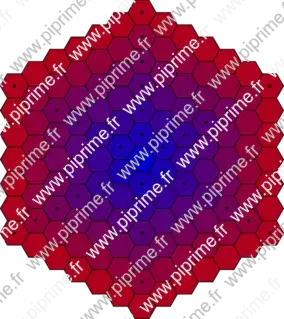
Show tiling/fig0010.asy on Github.
Generated with Asymptote 3.00-0.
Categories : Surveys | Tiling
Tags : #Tiling | #Function (creating) | #Picture
size(10cm,0); picture pavehexagonal(int depth=1) { picture opic; path hexa=polygon(6); pair center; real a,ap,r,rp,r_d=180/pi; for(int j=0; j<depth; ++j) { for (int i=1; i<=6; ++i) { a=i*60-30; r=j*sqrt(3); center=r*(rotate(a)*(1,0)); filldraw(opic, shift(center)*hexa, j/depth*.8red+(1-j/depth)*.8*blue); //Uncomment to see centers of hexagons dot(opic, shift(center)*midpoint(point(hexa,0)--point(hexa,3))); //Uncomment to see circles passing by centers //draw(opic, scale(r)*unitcircle, j/depth*red+(1-j/depth)*blue); rp=r; ap=0; for (real k=0; k<j-1; ++k) { r=sqrt((1.5*(j-1 - k))^2 + 3/4*(j+1 + k)^2); ap+=r_d*acos((rp^2 + r^2 - 3)/(2*r*rp)); center=r*(rotate(a + ap)*(1,0)); filldraw(opic, shift(center)*hexa, j/depth*.8*red+(1-j/depth)*.8*blue); //Uncomment to see the centers of hexagons //dot(opic, shift(center)*midpoint(point(hexa,0)--point(hexa,3))); rp=r; //Uncomment to see circles passing by centers //draw(opic, scale(r)*unitcircle, j/depth*red+(1-j/depth)*blue); } } } return opic; } add(pavehexagonal(7));
🔗tiling-fig002
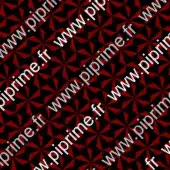
Show tiling/fig0020.asy on Github.
Generated with Asymptote 3.00-0.
Categories : Surveys | Tiling
Tags : #Tiling | #Clip
size(6cm,0); //Circular paving with the unit hexagonal picture "hexa" picture pavehexagonal(picture hexa, int depth=1) { picture opic; pair center; real a,ap,r,rp,r_d=180/pi; add(opic, hexa); for(int j=0; j<depth; ++j) { for (int i=1; i<=6; ++i) { a=i*60-30; r=j*sqrt(3); center=r*(rotate(a)*(1,0)); add(opic, shift(center)*hexa); rp=r; ap=0; for (real k=0; k<j-1; ++k) { r=sqrt((1.5*(j-1 - k))^2 + 3/4*(j+1 + k)^2); ap+=r_d*acos((rp^2 + r^2 - 3)/(2*r*rp)); center=r*(rotate(a + ap)*(1,0)); add(opic, shift(center)*hexa); rp=r; } } } return opic; } picture hexa; fill(hexa, polygon(6)); path inh=(0,0)--(.6,sqrt(3)/4)--(.5,sqrt(3)/2)--cycle; for(int i=0; i<6; ++i) { fill(hexa, rotate(60*i)*inh,.5red); } draw(hexa, inh); add(rotate(45)*pavehexagonal(hexa,10)); clip(scale(10)*shift(-.5,-.5)*unitsquare);
🔗tiling-fig003
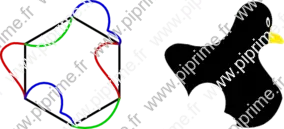
Show tiling/fig0030.asy on Github.
Generated with Asymptote 3.00-0.
Categories : Surveys | Tiling
Tags : #Path | #Picture | #Tiling
size(10cm,0); transform r60=rotate(60); pair A=(sqrt(3)/2,-.5); pair B=r60*A, C=r60*B, D=r60*C, E=r60*D, F=r60*E; path AB=A{dir(90)}..(.6,.5)..B{dir(0)}; path DE=shift(E-A)*reverse(AB); path BC=B{dir(45)}..(.75,.7){dir(150)}..{dir(135)}(.65,.75){dir(70)}..(.5,1.25)..C{dir(255)}; path EF=shift(F-B)*reverse(BC); path CD=C{dir(255)}..(-.4,.5){dir(200)}..D{dir(160)}; path FA=shift(A-C)*reverse(CD); draw(A--B--C--D--E--F--cycle,linewidth(2pt)); draw(AB,2pt+.8red); draw(DE,2pt+.8red); draw(BC,2pt+.8blue); draw(EF,2pt+.8blue); draw(CD,2pt+.8green); draw(FA,2pt+.8green); picture hexa; picture eye; filldraw(hexa,AB--BC--CD--DE--EF--FA--cycle,black,white); filldraw(eye,rotate(5)*xscale(.4)*unitcircle,white); filldraw(hexa,subpath(AB,1,2)--subpath(BC,0,2){dir(225)}..{dir(245)}cycle,.1red+yellow,white); draw(hexa,point(BC,0.1){dir(115)}.. (.8,.55) ..(.6,.65){dir(180)},yellow+grey); filldraw(eye,rotate(5)*xscale(.4)*unitcircle,white); fill(eye,rotate(5)*shift(0,-.1)*xscale(.25)*scale(.5)*unitcircle); add(hexa,shift(.6,.9)*scale(.1)*eye); add(shift(3,0)*hexa);
🔗tiling-fig004
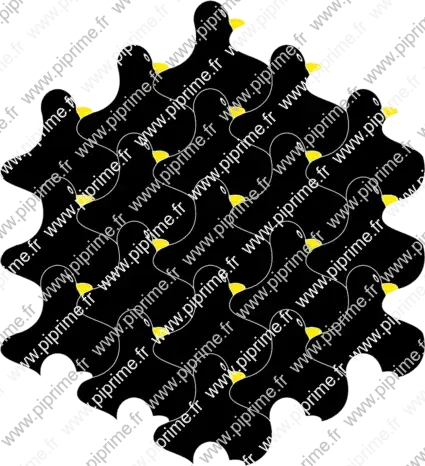
Show tiling/fig0040.asy on Github.
Generated with Asymptote 3.00-0.
Categories : Surveys | Tiling
Tags : #Tiling
size(15cm,0); transform r60=rotate(60); picture hexa; picture eye; pair A=(sqrt(3)/2,-.5); pair B=r60*A, C=r60*B, D=r60*C, E=r60*D, F=r60*E; //Body - corps path AB=A{dir(90)}..(.6,.5)..B{dir(0)}; path DE=shift(E-A)*reverse(AB); path BC=B{dir(45)}..(.75,.7){dir(150)}..{dir(135)}(.65,.75){dir(70)}..(.5,1.25)..C{dir(255)}; path EF=shift(F-B)*reverse(BC); path CD=C{dir(255)}..(-.4,.5){dir(200)}..D{dir(160)}; path FA=shift(A-C)*reverse(CD); filldraw(hexa,AB--BC--CD--DE--EF--FA--cycle,black,white); //Nozzle - bec filldraw(hexa,subpath(AB,1,2)--subpath(BC,0,2){dir(225)}..{dir(245)}cycle,.1red+yellow,white); draw(hexa,point(BC,0.1){dir(115)}.. (.8,.55) ..(.6,.65){dir(180)},yellow+grey); //Eye - oeil filldraw(eye,rotate(5)*xscale(.4)*unitcircle,white); filldraw(eye,rotate(5)*xscale(.4)*unitcircle,white); fill(eye,rotate(5)*shift(0,-.1)*xscale(.25)*scale(.5)*unitcircle); add(hexa,shift(.6,.9)*scale(.1)*eye); //Circular paving with the unit hexagonal picture "hexa" picture pavehexagonal(picture hexa, int depth=1) { picture opic; pair center; real a,ap,r,rp,r_d=180/pi; add(opic, hexa); for(int j=0; j<depth; ++j) { for (int i=1; i<=6; ++i) { a=i*60-30; r=j*sqrt(3); center=r*(rotate(a)*(1,0)); add(opic, shift(center)*hexa); rp=r; ap=0; for (real k=0; k<j-1; ++k) { r=sqrt((1.5*(j-1 - k))^2 + 3/4*(j+1 + k)^2); ap+=r_d*acos((rp^2 + r^2 - 3)/(2*r*rp)); center=r*(rotate(a + ap)*(1,0)); add(opic, shift(center)*hexa); rp=r; } } } return opic; } add(pavehexagonal(rotate(30)*hexa,3));
🔗tiling-fig005
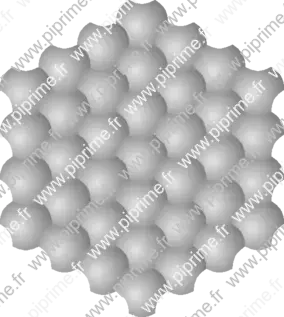
Show tiling/fig0050.asy on Github.
Generated with Asymptote 3.00-0.
Categories : Surveys | Tiling
Tags : #Tiling
size(10cm,0); transform r60=rotate(60); picture hexa; pair A=(1,0); pair B=r60*A, C=r60*B, D=r60*C, E=r60*D, F=r60*E; real ad=30; real tensio=.15; path AB=A {dir(120-ad)} .. shift(tensio*dir(30))*midpoint(A--B) .. B {dir(120+ad)}; path BC=reverse(rotate(240,B)*AB); path CD=reverse(rotate(240,C)*BC); path DE=reverse(rotate(240,D)*CD); path EF=reverse(rotate(240,E)*DE); path FA=reverse(rotate(240,F)*EF); real lux=-.3, sq=sqrt(3)/2; radialshade(hexa,AB--BC--CD--DE--EF--FA--cycle, lightgrey,(lux*sq,lux/2),0, grey,(lux*sq,lux/2),1+abs(lux)); //Circular paving with the unit hexagonal picture "hexa" picture pavehexagonal(picture hexa, int depth=1) { picture opic; pair center; real a,ap,r,rp,r_d=180/pi; add(opic, hexa); for(int j=0; j<depth; ++j) { for (int i=1; i<=6; ++i) { a=i*60-30; r=j*sqrt(3); center=r*(rotate(a)*(1,0)); add(opic, shift(center)*hexa); rp=r; ap=0; for (real k=0; k<j-1; ++k) { r=sqrt((1.5*(j-1 - k))^2 + 3/4*(j+1 + k)^2); ap+=r_d*acos((rp^2 + r^2 - 3)/(2*r*rp)); center=r*(rotate(a + ap)*(1,0)); add(opic, shift(center)*hexa); rp=r; } } } return opic; } add(pavehexagonal(hexa,4));
🔗tiling-fig006
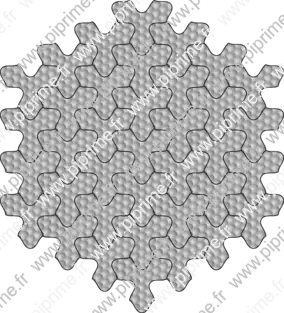
Show tiling/fig0060.asy on Github.
Generated with Asymptote 3.00-0.
Categories : Surveys | Tiling
Tags : #Tiling | #Clip
size(10cm,0); transform r60=rotate(60); pair A=(1,0); pair B=r60*A, C=r60*B, D=r60*C, E=r60*D, F=r60*E; real ad=30; real tensio=.25; path AB=A {dir(120-ad)} .. shift(tensio*dir(30))*midpoint(A--B) .. B {dir(120+ad)}; path BC=reverse(rotate(240,B)*AB); path CD=reverse(rotate(240,C)*BC); path DE=reverse(rotate(240,D)*CD); path EF=reverse(rotate(240,E)*DE); path FA=reverse(rotate(240,F)*EF); path pth1=AB--BC--CD--DE--EF--FA; real tensio=.5; path AB=A {dir(120-ad)} .. shift(tensio*dir(30))*midpoint(A--B) .. B {dir(120+ad)}; path BC=reverse(rotate(240,B)*AB); path CD=reverse(rotate(240,C)*BC); path DE=reverse(rotate(240,D)*CD); path EF=reverse(rotate(240,E)*DE); path FA=reverse(rotate(240,F)*EF); path pth2=AB--BC--CD--DE--EF--FA; //Circular paving with the unit hexagonal picture "hexa" picture pavehexagonal(picture hexa, int depth=1) { picture opic; pair center; real a,ap,r,rp,r_d=180/pi; add(opic, hexa); for(int j=0; j<depth; ++j) { for (int i=1; i<=6; ++i) { a=i*60-30; r=j*sqrt(3); center=r*(rotate(a)*(1,0)); add(opic, shift(center)*hexa); rp=r; ap=0; for (real k=0; k<j-1; ++k) { r=sqrt((1.5*(j-1 - k))^2 + 3/4*(j+1 + k)^2); ap+=r_d*acos((rp^2 + r^2 - 3)/(2*r*rp)); center=r*(rotate(a + ap)*(1,0)); add(opic, shift(center)*hexa); rp=r; } } } return opic; } picture hexa, hexat; real lux=-.3, sq=sqrt(3); radialshade(hexa,pth1--cycle, lightgrey,(lux*sq/2,lux/2),0, grey,(lux*sq/2,lux/2),1+abs(lux)); add(hexat,scale(1/(3*sq))*pavehexagonal(hexa,5)); clip(hexat,pth2--cycle); draw(hexat,pth2); add(pavehexagonal(hexat,4));
🔗tiling-fig007
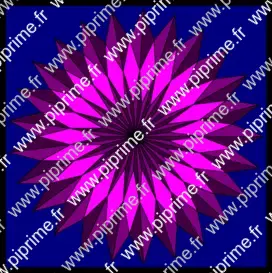
Author: Guillaume Connan.
Show tiling/fig0070.asy on Github.
Generated with Asymptote 3.00-0.
Categories : Surveys | Tiling
Tags : #Tiling | #Transform | #Shipout | #Fill/Unfill
size(10cm,0); void zigzag(int k) { real t=180/k; pair o=(0,0), m=dir(t), n=rotate(180-2*t,m)*o, b=rotate(4*t-180,n)*m, c=rotate(180-6*t,b)*n, nn=reflect(o,b)*n; path lo=m--n--b--nn--cycle, p=o--m--n--b--c--cycle, pp=reflect(o,b)*p; for (int i=0; i <= k; ++i){ filldraw(rotate(2*t*i,o)*p,.5*(red+blue)); filldraw(rotate(2*t*i,o)*pp,0.25(red+blue)); filldraw(rotate(2*t*i,o)*lo,(red+blue)); } } zigzag(25); shipout(bbox(3mm,2mm+miterjoin+black,FillDraw(0.5*blue)));